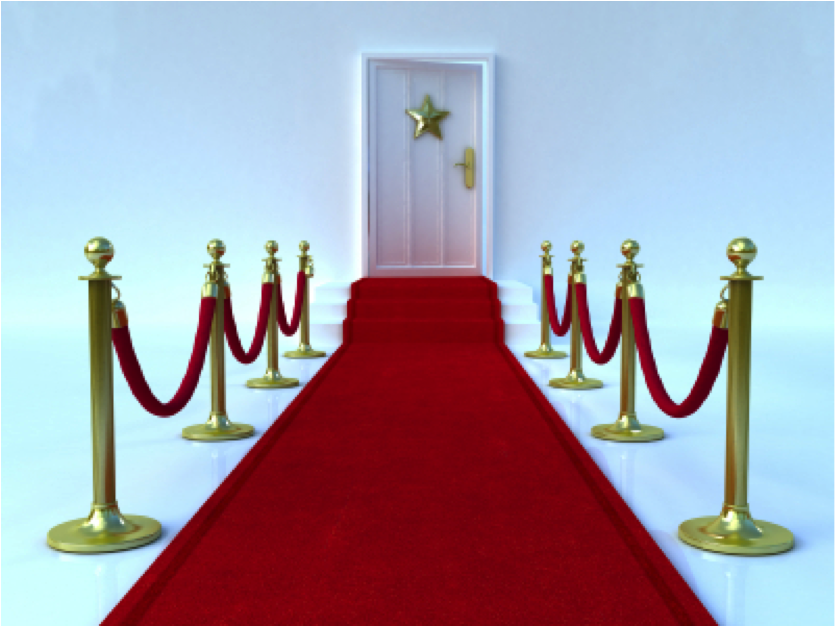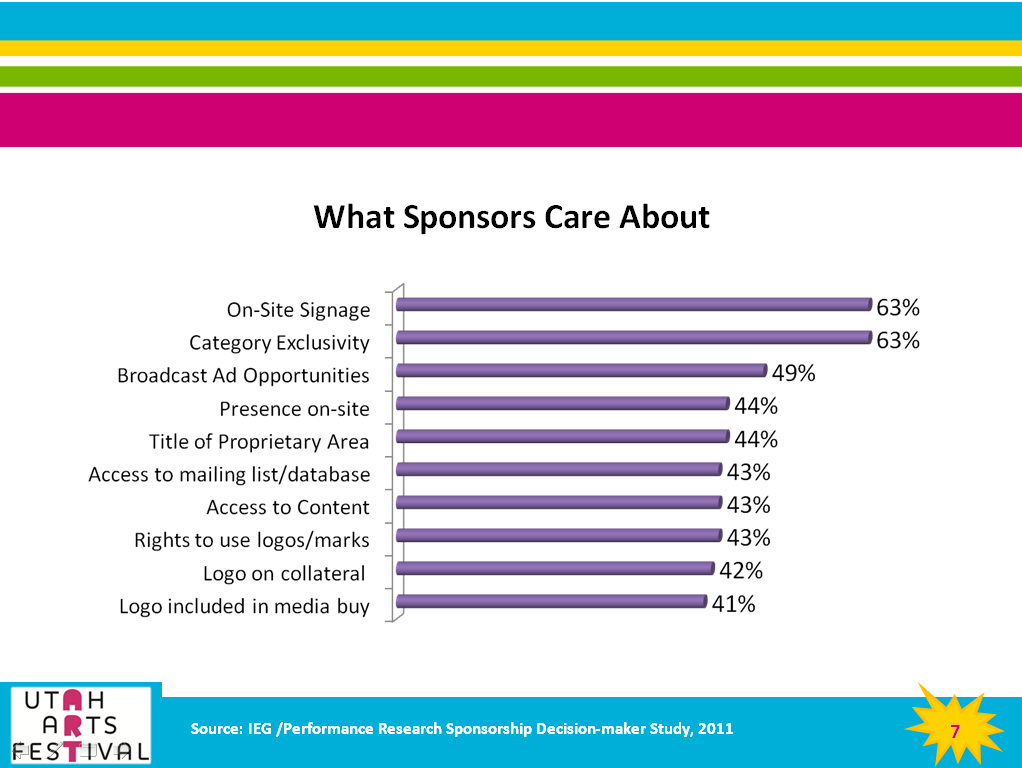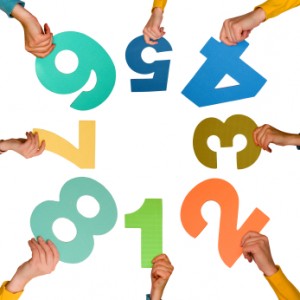8 Tips for Getting High Dollar Sponsorships for your Big Event
May is Party Month here at Fired-Up Fundraising and today Aimee Dunsmore, Development Director of the Utah Arts Festival, is sharing her secrets to getting HIGH DOLLAR sponsorships.
In the month of May we are going to drill down into HOW to maximize your dollar return from special charity events.
We all know that the big money in events comes from sponsorships.
So let’s nail our sponsorship strategy:
High dollar sponsorships for charity events are not really “philanthropy.”
They are also business-to-business marketing.
And your organization is one of the businesses!
Receive expert advice. Direct to your inbox. Subscribe
You’ll do much better if you approach your event sponsorships like old-fashioned sales.
1. Know your prospective sponsors’ marketing objectives.
They have multiple objectives. What are their priorities?
They see sponsorships as marketing strategies, but also overall as business strategy.
They want to align their brand with a good cause. They want exposure in front of your audience.
They may want exclusivity.
Do your homework!
Just remember that their “business” with you is often tied directly to sales and marketing objectives.
Find out how we can help you achieve your fundraising goals with world-class consulting and custom training.
2. Know what you have to offer a sponsor:
- Complimentary demographics?
- Complimentary psychographics?
- Impressions (eyeballs)?
- Tickets and access?
- Brand recognition and loyalty?
- Promotional rights?
- Access to your audience?
- Proprietary platform?
And, most importantly, what can you offer that NOBODY else can?
I like to ask the sponsor what’s most important to them. And then I work hard to provide it.
Here’s a chart from Aimee’s powerpoint presentation: what potential sponsor businesses care about:
Just look at all the things you can offer.
Just like any case for support, you’ll want to hit on as many positive angles as possible.
3. Know WHEN to pitch your event.
Aimee says that 45% of businesses make their sponsorship decisions in the last quarter.
Timing is everything.
It will take longer than you think for the decision to go thru the corporate ranks.
Give your sponsorship campaign plenty of time – months and months.
You’ll sell yourself short if you work on a really short time frame.
4. Know WHO the decision makers really are.
Is it the marketing team? The marketing VP?
Is it the community relations department?
Does the sponsorship decision go all the way up the corporate chain of command to the executive offices?
Do the advertising people play a role?
Every business is different. And smart fundraisers figure out who makes the final decision.
I like to have an “internal advocate” inside the company advising and guiding me through the maze.
5. Know WHAT TYPE of business best suits your event “product.”
You have a product you are selling to businesses.
They want exposure to your audience so they can market their company and their products.
Emphasize the “fit” between your audience and your potential sponsor.
Here’s something else interesting from Aimee Dunsmore:
6. Create the right offer with specific goals.
Your event prospect will respond better to measurable goals and objectives.
Run the numbers and lay them out.
Include benchmarks that the sponsor can use to measure the success of the sponsorship.
Explain the “features” of what they will buy.
More importantly (many nonprofits miss this) highlight BENEFITS to them.
Like all fundraising, the way you frame your “pitch” has everything to do with your success.
It’s about what THEY want and what they hope to achieve.
7. Add employee engagement into the mix.
Employee involvement is becoming more and more important to businesses.
Studies show that employees who volunteer together are happier and more productive at work.
(Help me find the source for that one if you can!)
So help the business kill many birds with one stone: marketing exposure, community responsibility PLUS employee engagement.
8. Make your proposal very SPECIFIC and relevant to their business.
Do your homework. Since you are researching their business strategy – you can emphasize what they are looking for.
I like to use their OWN language (pull from their web site or other materials.)
Lay out exactly what objectives they will achieve with this investment.
Don’t just assume that they know. Spell it out in black and white on the page.
And remember to emphasize what your event can uniquely do for the company.
BOTTOM LINE:
Approach high dollar sponsorships with a deliberate strategy.
(I’ve seen way too many haphazard, poorly timed, sloppy approaches in my day.)
- Allow enough time, do your homework, and create a clear business case.
- Play on existing relationships.
- Ask sponsors what they want. And give it to them cheerfully if you can.
Join Aimee’s webinar on Monday at 2pm ET if you want to learn more about raising high dollar sponsorships from a real pro!
I’m doing a series of webinars this month to help my INSIDERS subscribers wring the most $$ out of their events:
- 5/7 Getting High Dollar Sponsorships for Your Big Event, with Aimee Dunsmore.
- 5/15 How to Raise More Than Ever at Your Silent Auction, with auction expert Sherry Truhlar.
- 5/24 Using Technology to Make Your Silent Auction More Profitable with Sherry Truhlar.
- 5/31 How to Turn Your Fundraising Event into the Best Party in Town with yours truly.
You can join these webinars or find out more here.
Good luck and raise lotsa money!







So many great points! Understanding the business to business relationship, visibility, and employee engagement has been our strengths. We need to work harder on timelines and the other areas mentioned. Looking forward to learning more. I hope my nonprofit friends read this valuable information. I shared the link with most of them.
Hi! Glad you liked these ideas! It’s all business to business, isn’t it?
Gail, here is Deloitte’s study on Volunteer Impact http://www.deloitte.com/assets/Dcom-UnitedStates/Local%20Assets/Documents/us_2011DeloitteVolunteerIMPACTSurvey_ExecutiveSummary_060311.pdf
It highlights the benefits of company volunteerism
Thanks so much! I just knew someone might have that link!
great article thank you so much for this information Darin Harrell of Mainstagemusiclive.com
very helpful article!
Thank you!! Great article that has helped me understand how to approach sponsors for a very important maternity centre in my growing city.
Please know, by explaining all that you have in such detail you’ve helped so many people.
I really really appreciate your comment! Makes me happy to be able to support you and your work.
dear please help me i need 4000 dollar for my mother liver operation if have 2500,3000,3500 so please help me please 4r GOD say please help me please help me please please contact me on this number +923435252396
Thanks for this info! I am pretty new to looking at event sponsorship as a marketing partnership rather than a donation. What are some tips to find “internal advocates” and/or eventually “decision makers” without prior connections to a company? People keep saying LinkedIn. But LinkedIn just has the ability to InMail or Connect which seems as if it’d be a low percentage successful. Just cold calling the company and asking for the person? Any and ALL tips are greatly appreciated!
Hi Bran, I agree about Linkedin. But do call the company and find out the appropriate people to contact. I personally prefer to “network” my way into a company, via my friends, acquaintances, connections and/or donors to my cause. You can use Linkedin to find out who your own people know inside a company perhaps.
This is sooo helpful, I am a new breeder and wanted to do a Fun Show Fundraiser to help the English Bulldog Society and Rescue centers. This gives me a little more of an idea of how to approach certain companies, so I am crossing my fingers for a positive outcome. Thank you so much for all the information and I will keep following you and all your advice for future events.
Hey, so trying to start a Non profit band to get kids off of all the LSD, and mind manipulating drugs. need a headstart, found this page. keep it slick, DST xx>
Good article. Are you a sponsor? Looking for a TItle Sponsor for our exclusive event for details Email us to TitleSponsor@gmail.com
Great article a true gem.
Glad it was helpful!
I am trying to get sponsors for my daughter. She was selected as a state finalist for Pennsylvania for the National American Miss Pageant. We seem to be having trouble getting sponsors for her and our funding is very tight because I am a stay at home mom that has anxiety and depression that prevents me from working, I home school my children and I take care of my father that has stage 4 small non-cell lung cancer. My husband is the only person that works and the money he makes goes towards the bills and to keep a roof over our heads. We have a go fund me, I’ve had people try to do fundraisers but we are always hitting a dead end Please, Please, Please we need help ASAP. I only have until the first week in August. Thanks
Am a Kenyan by nationality and I sincerely request for an aid in raising an institution which will as well try to eradicate illiteracy at our grassroot levels and try to improve the mental picture of our society so kindly advice on who to address,
Thanks
Is it too late to secure sponsors for my February 2018 events?
PEACE DEVELOPMENT FELLOWSHIP ORGANIZATION REGISTERED I NEED A SPONSORSHIP MONEY FOR MY PROJECT.
This is article is super helpful. My name is Genee Carr and I am co-owner of Eventfull Productions. We are an event planning company that specializes in social events. I have recrntly been more intrigued by the idea of throwing an charitable event. This was just the info I needed to get started with pitching my idea to different sponsors. Thanks so much!
Great information! Many valuable tips on acquiring sponsors. Thanks!
can i get a sponsor for my organization, Uganda Public Rescue Foundation is a nonprofit Human Rights organization that offers legal aid to indigent persons in Uganda, conceived in the year 2008 in the context of justice and order sector reforms as one of the models for improved administration of justice in Uganda. The foundation envisions the society in which disadvantaged people have improved access to justice in fulfillment of the constitutional requirements. It has a mission of establishing national mechanism for public defense of poor people and human rights promotion. Given the period UPRF has been in the existence while extending legal aid services to the indigent persons, it has the capacity to carry on its niche of offering opportunity to the marginalized, vulnerable and poor people to access justice thus the need for parternship.
Email; info@uprf.org
Web; http://www.uprf.org
Hi, Gail..That was really very good peice of advice for new comers in the industry. Thanks for jotting down so nicely.